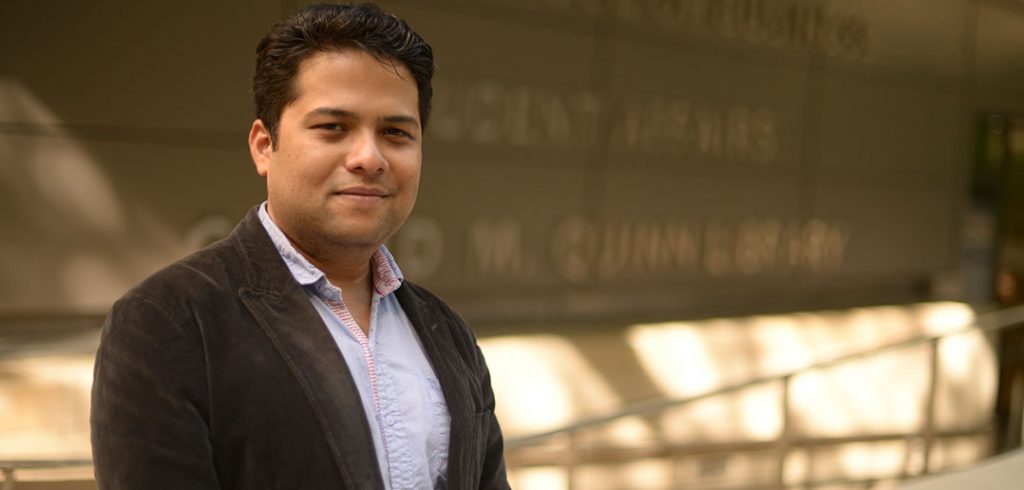In today’s fast-changing business environment, it’s not enough to understand technology or media. The two have become intertwined in ways that were previously unimaginable.
For Mumbai, India, native Samrat Dhar, a desire to master this new reality drew him to the Gabelli School of Business, where he’s earning an M.S. in media management.
After earning a B.S. in economics in 2007 from St. Xavier’s College in Mumbai, Dhar worked for a hedge fund, for Groupon, and most recently, for a gaming company for mobile devices that he founded with his brother. He was also making short films on the side, and in 2017, he started looking for a way to jumpstart his entrepreneurial ambitions.
New York as Tech and Media Hub
“There were programs in the Midwest, and even in Boston, but I thought New York was a better environment because there are more tech people in New York than there are in Silicon Valley,” he said, pointing to the recent $200 million sale of New York-based digital news company Cheddar as an example.
“The Flatiron district is the perfect incubator for all sorts of new tech startups. There’s so much happening there. The talent is now readily available on the East Coast, which wasn’t the case 10 years ago.”
As a St. Xavier graduate, Dhar was attracted to the familiarity of Fordham’s Jesuit heritage. But New York City was brand new to him. He came here with no preconceived notions, he said, and found the city to be welcoming and warm. His experience at the Gabelli School was equally positive.
“The best thing about my experience the last two years has been the curriculum, and how you have the liberty to structure it in the direction that you want it to go based on what you see yourself doing 10 or 15 years from now,” he said.
“It allowed me the flexibility to take courses in finance, strategy, and entrepreneurship.”
Exploring the Stories That Unite
It also allowed him to direct Unexplored India, a 23-minute-long forthcoming documentary about an annual fair in Mhasa, a tiny hamlet 50 miles northeast of Mumbai. The village takes its name from the Hindu deity Mhasoba, and the fair, which is a tribute to Mhasoba, is a common way for villages around the country to honor deities. Fairgoers come from neighboring villages and even other states to honor Mhasoba, which translates to “Buffalo God.”
“What drew me to this was how folklore crosses boundaries and borders. In India, there are so many diverse states, and every state has a different language and a different culture. But there are certain things that can hold people together,” he said.
Bozena Mierzejewska, Ph.D., an associate professor of media management, who supervised Dhar’s independent study, said that the master’s program’s flexibility is no accident.
“The media industry is so diverse, it would be very difficult to give a set of say, five classes, and then say, ‘You know everything,’” she said.
“Because if you want to be a filmmaker, it’s different than if you want to be in the book publishing industry. So there are three core courses, and then you design your electives around your main interests.”
The Future of Technology and Entertainment
Of all the courses he took, Dhar said Consumer Adoption of New Media resonated the most. He learned a great deal about emerging trends in media consumption, such as holographic TV.
“Couple that with the entrepreneurship course, you could actually build a business idea around it. You can see how all that information can be made relevant for the future,” he said.
“When you’re in that environment where there’s a lot of thinking happening, whether by yourself or your peers, it forces you to come up with more innovative ideas.”
Spending time in New York opened his eyes to an area of finance that he had not been exposed to when he first entered that field: private equity and venture capital firms that specialize in media and the entertainment industry. It helped him understand why the city is often referred to as the media capital of the world.
“One of my most memorable experiences was a visit to the Time Warner Medialab, where they create focus groups and have been trying to essentially build a system to evaluate whether a project will do well,” he said, noting that measuring audience reactions has taken an almost clinical approach. “They get people of different demographics to participate, and they measure not just responses to questions, but also things like their vital stats, their heartbeat.”
Dhar is weighing several options for jobs after graduation. He may work for himself but would also consider working for an established firm. One thing he’s sure of is he will stay in New York City.
“So far, I’ve seen the academic life. Now I’d like to see the professional life of the city,” he said.
Mierzejewska said she expects Dhar to find success in whatever path he chooses. She was impressed with his devotion and compared his independent study to the kind of work that doctoral students might tackle.
“He didn’t just do a research paper; he did an analysis of all the materials that will help young filmmakers manage a project,” she said.
“He was trying to learn theory on the one hand and develop his film documentary on the other. It was very unique, very ambitious. It was all coming from his own natural talent, which I found to be extraordinary.”


